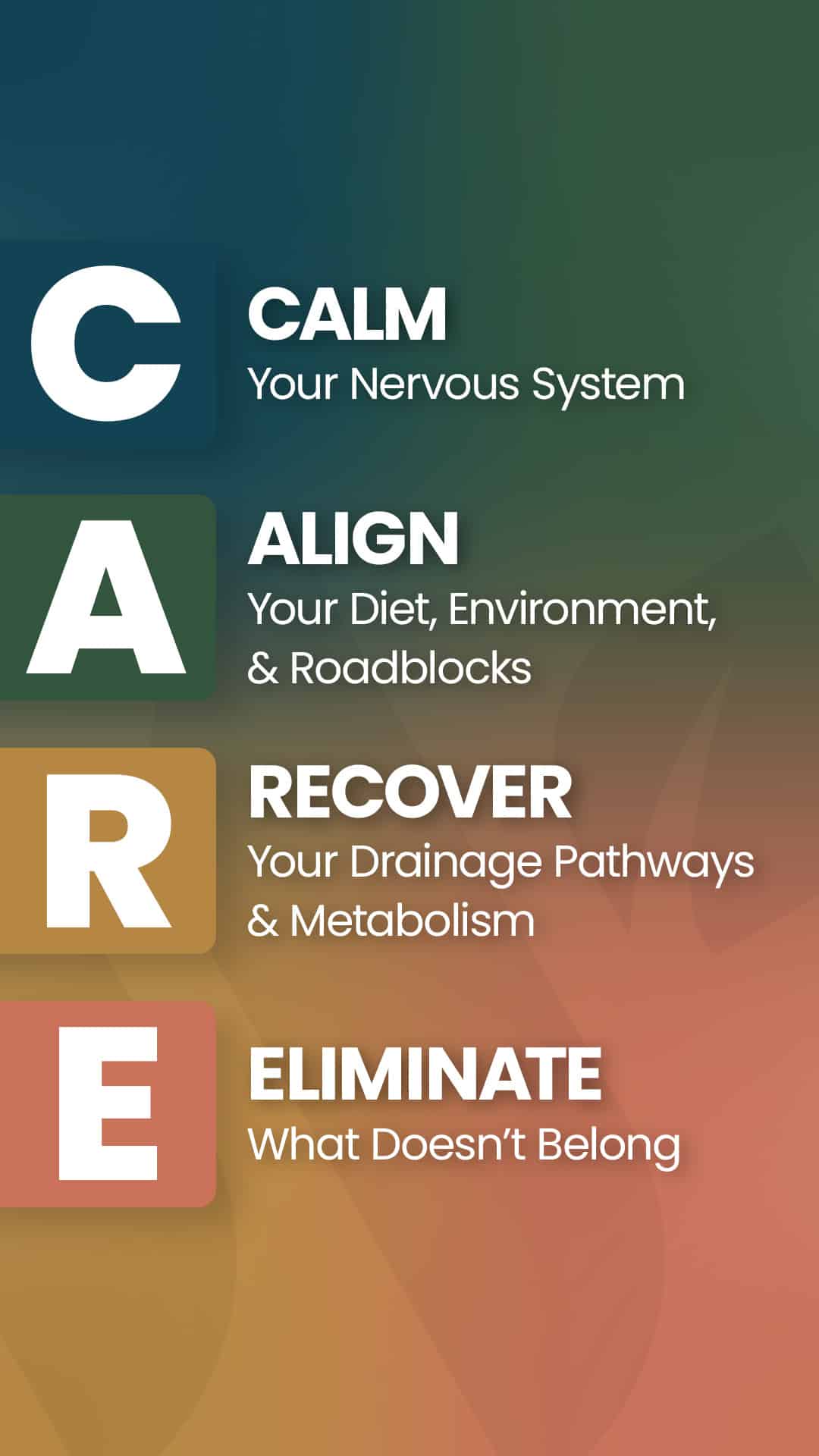
Healing Journey Insights & Tools
- Home
- Blog
- Anxiety & Stress
- Are Stealth Infections Like Lyme or Mold Behind Some Mental Health Diagnoses?
Are Stealth Infections Like Lyme or Mold Behind Some Mental Health Diagnoses?
Recent studies are now linking mood disorders and neurodegenerative conditions to inflammation, rather than neurotransmitter imbalances as previously thought. That former hypothesis drove the sales of SSRI antidepressants. However, those drugs didn’t work any better. Up to 50% of patients experience refractory depression that is unsuccessfully treated by SSRIs.
So where is the inflammation coming from? What is the root cause?
In my professional opinion, it is a biotoxin illness in many cases. Under-diagnosed and overlooked by mainstream medicine, I have seen it cause enough inflammation to elicit mini-strokes (transient ischemic attacks)and pericarditis.
Biofilm disease, stealth infections, traumatic brain injuries, and psychiatry
Inflammatory markers are well-documented in psychiatric literature. Stealth infections, like candida, herpes, mold, Lyme and its co-infections, can all elicit rampant inflammation and fatigue in the body by disrupting cytokine function and spinning the hypothalamus-pituitary-adrenal (HPA) axis down, respectively. This is usually the first step in the CIRS biotoxin timeline—-chronic fatigue and anxiety. This snowballs into androgen deficiency, immune dysfunction, even and mood disorders.
Since biotoxins hide in the lymph and mucous membranes, they often affect the gut and digestive function. LEAKY GUT, LEAKY BRAIN. The reverse is also true. Traumatic brain injuries (TBI) have shown us that a brain injury can also elicit leaky gut. The two are bi-directional. TBI appears to act upon the transmembrane proteins responsible for creating the intracellular scaffolding necessary to maintain tight junctions between intestinal epithelial cells. In one study, the transmembrane proteins ZO-1 and occludin were measured after a TBI to determine intestinal permeability. TBI caused a significant increase in intestinal permeability within 6 hours after injury, as marked by the decreased expression of ZO-1 and occludin, by 49% and 73%, respectively.
Research shows that the microglia, or immune cells, in our central nervous system, are persistently activated by a head injury. This is highly associated with neurodegeneration as well as bipolar disorder. Cytokines have been shown to increase the permeability of the blood-brain barrier membrane and the tight junctions in the gut. There are several ways it can happen. Inflammatory cytokines like IL-1, IL-6, and TNF, MMP9, and TGF-beta; as well as bacterial toxins and by-products, (lipopolysaccharides, LPS) have all been associated with increasing the permeability of the brain and gut lining. I’m going to attempt to connect this cascade to the beginning of a neurodegenerative condition, like Alzheimer’s disease here.
As I mentioned in my previous blog on mycotoxins, 25% of the population has a genetic haplotype that predisposes them to persistent CIRS. If you add up everyone in the United States that’s been diagnosed with a psychiatric illness it’s around 20%. This might be coincidental, but scientific evidence throughout history indicates otherwise.
Mood disorder or undiagnosed infection?
Lyme disease, which plagues more people than breast cancer, can cause psychiatric symptoms like depression, seizures, and suicidality. Lyme is caused by a spirochete, a bacteria which is corkscrew-shaped. This means it can burrow into tissues like the brain, mucous membranes, and other parts of the neurologic system. It is a cousin to syphilis, which is rumored to have been the psychiatric downfall of Napoleon. They behave very similarly and are experts at hiding from the immune system by forming a sticky biofilm that acts as a wall against the body’s defenses.
Mold is known to cause personality changes, depression, anxiety, and chronic fatigue. In fact, in one study, researchers surveyed 6000 Europeans and found moderately higher depression (up to 40%) in those that lived in visibly moldy houses. Clostridium, the gram-positive anaerobic bacteria, is implicated in schizophrenia and autism in some patients. It’s also connected to addictive behavior. Bartonella, or cat scratch fever, is another tick-associated illness linked to ice pick headaches, neurologic symptoms, and rage episodes. PANDAs, the neuropsychiatric illness that appears in children, is thought to be triggered by Streptococcus and can present as outbursts, obsessive-compulsive behavior, and anxiety. Some of the literature showed active HHV-6 in the autopsied brains of depressed patients and patients diagnosed with bipolar disorder.
Many of the immune markers that indicate biotoxin illness or CIRS, or chronic inflammatory response syndrome, also are indicative and suggestive of stark inflammation, including neuroinflammation. New studies are now linking mood disorders, like anxiety and depression, to neuroinflammation rather than blaming it all on genetics or imbalanced neurotransmitters. These markers include
- MSH
- VIP
- VEGF
- TGF-beta 1
- MMP9
- C4a
- ACTH/cortisol
- ADH/osmolality
These are linked to dysregulated hormonal, neuroendocrine, gastrointestinal, and immune function. This is an all over-body, systemic attack (more of this to come).
Some of the best evidence for this is in schizophrenia disorder. Schizophrenia is strongly correlated with toxoplasmosis, an obligatory parasite that invades the brain and can be contracted from cat litter boxes. Another study shows how inflammation and a higher incidence of Celiac disease, or gluten intolerance, is strangely found among schizophrenics. My opinion? Gluten has been adulterated from its natural version and feeds stealth infections which are the root cause of schizophrenia.
Is the body attacking itself or reacting to a hidden presence?
And that’s just psychiatric conditions! These infections can cause other chronic health issues. Many stealth infections are also connected to autoimmune conditions. A recent study out of Cincinnati connected Epstein Barr virus (EBV), a member of the herpes family, to seven different autoimmune conditions including multiple sclerosis, juvenile diabetes, and Celiac disease. It is well established that EBV is behind Burkitt’s lymphoma, nasopharyngeal carcinoma, some types of Bell’s Palsy, and Guillain Barre syndrome.
Viruses may elicit autoimmune conditions through complex processes including molecular mimicry, where the host and pathogen share a common immunologic epitope that ultimately confuses the body. Autoimmunity can also occur through bystander activation and an overzealous immune system, or by persistent stealth infections, that can reactivate throughout the life of the host, especially under opportunistic conditions. (i.e. stress).
An answer for Alzheimer’s?
Alzheimer’s disease (AD) is the third cause of death in the United States and over 47 million people live with it around the world. Alzheimer’s is characterized by the accumulation of amyloid plaques and neurofibrillary tangles between the neurons in the brain.
Alzheimer’s disease type 3 has been found to be a direct result of exposure to certain toxins that accumulate over time and begin to degrade the brain. Inhalational Alzheimer’s, or type 3 Alzheimer’s Disease, produces lab results similar to chronic inflammatory response syndrome (CIRS) patients. However, their symptoms will look more like AD dementia rather than mold toxicity. In this study done in 2010, the researchers link higher levels of inflammatory cytokines that affect the brain to AD. In the cerebrospinal fluid, they found all the usual markers of CIRS-TGF beta, IL-1, IL-6, and tumor necrosis factor.
A 2014 study found fungal macromolecules in the brains of Alzheimer’s patients, directly supporting the categorization of type 3 AD. In addition, a 2015 study found fungal infections in the brains of 10 Alzheimer’s patients further supporting the fact that mold can cause Alzheimer’s disease. The most recent study published in the journal Aging in 2016, directly correlated CIRS as well as heavy metal exposure, to the cause of type 3 Alzheimer’s disease. The jury is in: MOLD CAN CAUSE ALZHEIMER’S.

“Ochratoxin, aflatoxin produced by the insidious black mold, Aspergillus, depletes striatal dopamine, which is highly associated with movement disorders like Parkinson’s. It also depletes the hippocampus, which is where our memories are stored. That’s good evidence that ochratoxin will be damaging the parts of the brain associated with mood and movement disorders, to produce long term effects.” (4) Ask anyone with mycotoxin or biotoxin illness, and they’ll sympathize with the severe brain fog and inability to think clearly. Many even say they understand how it can fully bloom into a neurodegenerative condition like AD.
The increasing number of reports of various pathogens identified in the brains of patients with Alzheimer’s disease—from viruses such as Herpes simplex to oral bacteria such as P. gingivalis [9] to fungi such as C. glabratus [7]—raises the possibility that what is referred to as Alzheimer’s disease may actually be the result of a protective response to various brain perturbations.”
The truth is that many more infections besides mold, have also been found in the autopsied brains of Alzheimer’s patients, which likely can contribute to the quality and severity of the condition.
It seems that our bodies are trying to protect us, even if it’s to our demise. In my opinion, the toxicities of the environment lead to lowered immunity and predispose us to collective infestations. There is a root cause!
Biotoxin illness-addressing the brain-adrenal axis is the first step
Chronic fatigue and anxiety are usually the first symptoms a patient who is developing biotoxin illness will likely feel. Why? Normally, when a person comes in contact with a biotoxin-producing organism, the immune system is able to bind, tag, and remove it effectively. In CIRS, antigen-antibody recognition becomes impaired. The consequences of that are continual and improper activation of the cytokine response AKA inflammation. The overactive immune system, coupled with a dysfunctional adaptive immune system, leads to multifaceted and multi-systemic disease syndrome.
The first symptom is often fatigue, no matter how much one sleeps. At first, some patients may feel “wired but tired,” as the body tries to surge cortisol and fight the infection. Eventually, the talk between the brain and the adrenals bottom out, leading to low cortisol and a higher risk of autoimmune problems.
This inflammation can build over time. Occasionally the body gets a glimpse of the invader and increases the cytokine and inflammation cascade. This can be a risk factor for transient ischemic attacks or mini-strokes as well as pulmonary emboli and heart attacks. Keeping the blood thin with fibrinolytic enzymes during this time is advised.
Another risk factor for early burnout and adrenal dysfunction is adverse childhood events (ACE). Studies have routinely demonstrated that the more ACEs you have, the higher the risk of disease and autoimmunity. In fact, compared with persons with no ACEs, persons with ≥2 ACEs were at a 70% increased risk for hospitalizations with Th1 autoimmune conditions, 80% increased risk for Th2 autoimmune conditions, and 100% increased risk for rheumatic diseases (p < .05).
Unfortunately, our brains are still malleable as children. Stress incurred at a young age is relevant! Abuse ingrains certain neuronal firing, responses, cortisol levels, and increased inflammation through cytokine activation in the microglia of the brain.
The next step in taking over your body is androgen deficiency and then eventual melatonin disruption and immune dysfunction. Recall and executive function are relatively impaired.
Mold, biotoxin illness, and mood disorders: neurotransmitter pathways
Any pathogen with a biofilm has the potential to take over the body insidiously, but most have their signature abnormalities with neurotransmitters. For instance, Clostridium, linked to addictions, aggression, and even autism and schizophrenia, works by inhibiting the breakdown of tyrosine, the precursor to dopamine. It is the excitatory nature of this neurotransmitter that is responsible for the obsessive compulsive-like behaviors seen in autism. Dopamine oversees the reward-pleasure center as well as a compulsion, so it is easy to see how this could spiral into addiction or overstimulation in some patients.
On the other end of the spectrum is Parkinson’s, which has too little dopamine, leading to rigidity, anhedonia, and depression.
Not all hidden infections produce this picture though. Many produce lower amounts of serotonin due to inflammation. Serotonin controls mood, movement, immune function, and sleep. As you can see, tryptophan, the sleepy amino acid famously found in turkey, is the precursor to making serotonin, which is really important. Serotonin not only makes us happy but goes on to make melatonin, so it ultimately helps us sleep too.
But if we have inflammatory cytokines present from trauma or infections like mold, the pathway to make serotonin is not followed. Instead, the immune system activates the kynurenine pathway and leads to making quinolinic acid. Quinolinic acid is strongly correlated to depression and suicide. It also degrades tryptophan. Quinolinic exerts its effects by antagonizing the glutamatergic, or excitatory pathway. It involves the NMDA receptors, which are associated with inflammation, psychosis actually, and probably suicide. It has been shown to be elevated in the cerebrospinal fluid of suicide victims. In fact, ketamine may exert anti-suicidal effects by counteracting the kynurenine metabolites
Multiple studies indicate this pathway in depression and suicide. Novel approaches are currently looking at ways to treat mood disorders by understanding the activation of quinolinic acid and its metabolites. This is literally the inflammatory state associated with illness and is not controllable or psychological.
We do have studies that show that CIRS/biotoxin illness can directly damage the brain. Dr. Shoemaker, cited below, found people with elevated TGF-beta and MMP9 have a frontal lobe, hippocampus, and cerebellum edema or swelling. Dr. Amen, a renowned integrative psychiatrist, owns a clinic that has used SPECT imaging to display mycotoxin damage to the brain.
See below for some examples of biotoxin-causing pathogens that can be found in water-damaged building exposure.
Types of toxins, inflammagens, and microbes associated with water-damaged buildings:
- Fungi
- Aspergillus penicillioides Aspergillus versicolor, Wallemia sebi, Stachybotrys chartarum, Chaetomium globosum
- Fungal fragments
- Mycotoxins, hyphal fragments, conidia, mannans, spirocyclic drimanes, Chitinases
- Protozoa
- Protozoa and amoebas
- Bacteria
- Gram-negative bacteria, gram-positive bacteria, mycobacteria, chlamydia, mycoplasma
- Bacteria fragments
- Endotoxins, Lipopolysaccharides, Actinomycetes, Nocardia, Hemolysins
- Inflammagens
- Siderophores, beta-glucans, cell wall components, cell fragments, proteinases
- VOC’s
- Microbial VOCs, building material VOC’s, inorganic xenobiotics
- Particulates
- Bioaerosols, coarse particulates, fine particulates, ultrafine particulates, nano-sized particulates
Treatment
You are unique. Treatment should be under the guidance of a Lyme literate doctor or one who is skilled in stealth infections like Lyme or Mycotoxins. Diagnosis can prove difficult for many patients, who end up being victims of the system until some savvy doc figures them out. Some go years, trying multiple antidepressants or antipsychotics to no avail. Some end up diagnosing themselves and seeking out treatment.
Never miss another stealth infection patient by always screening with these questions:
- Have you been bitten by a tick, bedbugs, mosquito or fleas which elicited an odd immune reaction, or rash, specifically a bullseye rash?
- Have you been exposed to a water-damaged building or leak?
- Do you have brain fog, bloating, joint pains, rashes, headaches, sinus problems, eye floaters, electric shocks on the skin, ear ringing or difficulty holding your urine?
- Do you have ice pick headaches or pain on the soles of your feet?
- Do you have mood swings, frustration, addictions, or rage episodes?
- Do you have a dairy sensitivity or sore muscles?
- Do you have rectal itching or grind your teeth at night?

Again, treatment should be made individually for each patient and their specific diagnosis. However, some of the mainstays from my treatment plan includes DHA, EPA, other fish oils, DHEA, or glandular for adrenal support if needed, vitamin D, binders like activated charcoal, clays, apple pectin. In my protocol, kill, bind, sweat for elimination as well as heat shock protein activation, occurs daily. Coffee enemas, colonics, IV ozone or ozone sufflations, hemp products, and lymph massages might also be employed on a case by case basis. It is extremely important to ensure that the patient’s detox pathways are functioning properly.
As expected, a strict diet is necessary. Remember the link between schizophrenia, anti-gliadin antibodies, and gluten? Eliminating gluten, which feeds neuroinflammation and other infections, is imperative. It’s also helpful to get rid of processed dairy, factory-farmed meats, soy, caged eggs, and SUGAR. An anti-inflammatory diet protects the brain and the gut. High levels of healthy fats are highly encouraged.
Consider that Dr. Terry Wahls put her multiple sclerosis into remission eating more than 15 servings of vegetables a day, grass-fed meats, weekly organ meats, wild-caught fish, and healthy fats.
Integrative programs, with multidisciplinary physicians working together, may be necessary. Patients may need psychotherapy or counseling to get past childhood trauma, which plays into their physical ailments. Moving may be indicated if mold is found, and this can be a roadblock for healing in some cases. Patients may also require mainstream medical interventions or drugs occasionally. All of this is to be expected in the realm of healing.
Expect at least a 3-month treatment plan for biotoxin illness, and often longer depending on how indolent the infection is. The truth is that you can heal and feel human again. Reclaim your life.
REFERENCES:
- Shoemaker RT., MD . Surviving mold: life in the era of dangerous buildings. Baltimore, MD: Otter Bay Books; 2010.
- https://www.survivingmold.com/docs/CIRS.JLS.FINAL.PDF
- http://www.survivingmold.com/diagnosis/neuroquant
- https://www.survivingmold.com/community/mary-ackerley-the-brain-on-fire-the-role-of-toxic-mold-in-triggering-psychiatric-symptoms
Real Progress From
Real People
FREE CARE Plan eBOOK by Dr. Jess, MD.
This system mirrors Dr. Jess MD's steps with patients in her virtual clinic. It’s not a diagnosis, it’s a roadmap; a step-by-step process designed to help people restore function, remove roadblocks, and rebuild resilience.

